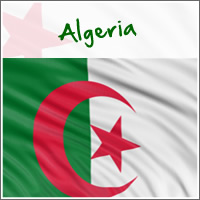|
|
 |
It is the first largest country of the Mediterranean sea, the second on the African continent and the 11th largest country in the world in terms of total area. Algeria, in northwest Africa, is part of the region known as the Maghrib. The continent's second-largest nation (after Sudan), Algeria borders Tunisia, Libya, Niger, Mali, Mauritania, Morocco, and Western Sahara. Given its geographic location, Algeria has long interacted with African, Asian, and European cultures. The bitter Algerian War (1954-62) that ended French colonial rule has significantly influenced Algeria's national identity. Since gaining independence, Algeria has tried to liberate itself from the economic legacy of colonialism through ambitious development plans financed by the sale of petroleum and natural gas. |
Algerians are primarily of Arab and Berber descent. Arabic, the national language is spoken by about 82% of the population, but Berbers have historically resisted "Arabization." They protested a new law introduced in 1998 that made Arabic the only language permitted in public life. They have quite a few agricultural products that benefit everyone like, wheat, barley, potatoes, citrus fruits, olives, grapes; livestock rearing (sheep and cattle). Their Major trading partners France, USA, Italy, Germany, Spain Resources natural gas and petroleum, iron ore, phosphates, lead, zinc, mercury, silver, salt, antimony, copper Industries food processing, machinery and transport equipment, textiles, cement, tobacco, consumer goods Exports crude oil, natural gas, refined products, tobacco, hides, dates. Algeria's flag has two equal vertical bands of green and white (green is by the flagpole); in the centre of the flag is a red crescent and a smaller, red, five-pointed star located within the crescent. The crescent and star, and the colour green are traditional symbols of Islam (which is the official religion of Algeria). The colour white symbolizes purity. The Algerian flag has a ratio of 2:3 (height to width). Algeria's flag was adopted on July 3, 1962, after Algeria became independent from France. Algeria's national holiday is Revolution Day, celebrated on November 1. In Algeria they eat Couscous, semolina-like pasta made from cracked wheat, is a staple food in Algeria and throughout North Africa. Rice is also a popular staple, and chickpea-cakes make a cheap and tasty accompaniment for food. Pizza, fried chicken, and potato fries are popular among younger Algerians. |
    |
